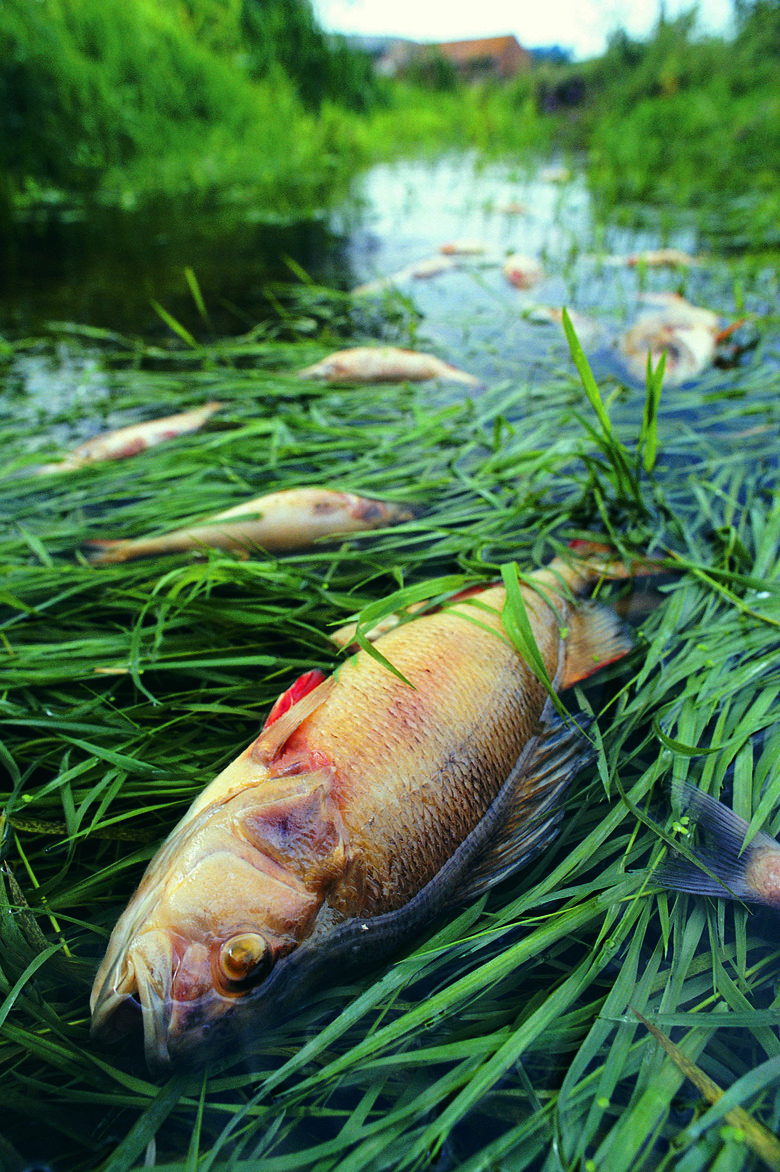Pollution's Effects On Animals
Pollution comes in many forms and impacts a wide variety of creatures. The effects of land, air and water pollution on animals and birds can be devastating. Pollution created by human activity factors into the decline of many threatened or endangered species, and also adversely impacts humans, fisheries, tourism and more.
Effects of Pollution on Amphibians
Effects of Pollution on Amphibians
Amphibians such as frogs and salamanders are the poster child for the negative effects of water pollution because they have such incredibly sensitive skin. They have the unique ability to absorb oxygen through their skin, but this also leaves them susceptible to absorbing dangerous chemicals as well.
Pesticides, nitrogen-based fertilizers and heavy metal contaminants all pose a direct danger to these creatures. These pollutants often find their way into water systems via runoff after heavy rain. In addition to directly killing amphibians, these pollutants can also weaken their immune system (as may have been the case in the extinction of the Monteverde golden toad) and cause physical deformities or abnormalities.
Pollution and Birds
Pollution and Birds
Amphibians are far from the only animals affected by pollution in water. Fish and invertebrates also end up with these contaminants in their systems as well. Though small amounts might not kill the fish, those chemicals stay in their system. This poses a danger to the predators in the food web, such as birds of prey.
Peregrine Falcons showed this danger explicitly when their populations plummeted due to the use of the pesticide DDT. The birds fed on fish and small mammals affected by DDT in their environment, and the chemicals within their prey built up inside the falcons through bioaccumulation. This caused sickness in Peregrine Falcons and weak eggshells in breeding females; reproductive success plummeted, and the birds became an endangered species.
Outlawing DDT and similar pesticides resulted in a successful population recovery of this species and removal from the endangered species list.
Sea Lions and Bioaccumulation
Sea Lions and Bioaccumulation
Birds of prey are not the only predators impacted by the bioaccumulation of pollutants. Sea lions and other marine mammals are yet another example of animals affected by pollution. In the case of sea lions, fertilizer runoff results in harmful algal blooms. This algae releases a neurotoxin known as domoic acid. Fish eat this harmful algae and accumulate it in their bodies, and the sea lions eat the fish.
Through bioaccumulation, the sea lions ingest high levels of toxic domoic acid, resulting in domoic acid toxicosis. The condition causes neurological issues, seizures, aborted pregnancy, and if untreated, death. Decreasing pesticide and fertilizer use can reduce harmful algal blooms and protect sea lions and their entire ecosystem.
Marine Debris
Marine Debris
Sea lions and other marine mammals are far from the only sea creatures impacted by oceanic pollution, and chemical pollution is absolutely not the only dangerous form of ocean pollution. Marine debris also poses a danger to many different animals in the ocean – this term refers to any man-made object that has been discarded and found its way into the ocean.
Many different types of marine debris cause harm to oceanic animals. Marine mammals, birds, turtles and sharks often become entangled in discarded fishing gear such as nets and lines. Plastic objects get mistaken for food items, and many animals ingest them. Plastic bags are a particularly troublesome form of marine debris.
Sea Turtles Eat Plastic
Sea Turtles Eat Plastic
Sea turtles in particular ingest large amounts of plastic debris. Plastic bags pose a problem in particular because they look similar to jellyfish or algae, the primary prey to some sea turtle species. In fact, researchers believe that over half of the world's sea turtles have consumed plastic at one time or another.
Ingesting plastic can result in decreased ability to digest foods and intestinal blockage. The plastic generally cannot pass through their system and typically results in death unless treated. Recycling plastics can help reduce the amount of marine debris in the oceans and protect sea turtles and other wildlife.
References
- AmphibiaWeb: Chemical Contaminants
- Animal Diversity Web: Peregrine Falcon
- National Ocean Service: What Is Nutrient Pollution?
- The Marine Mammal Center: Red Tides and Domoic Acid Toxicity
- World Wildlife Fund: What Do Sea Turtles Eat? Unfortunately, Plastic Bags
- U.S. Department of the Interior: Marine Debris Impacts
- Rainforest Trust: Thirty Years After the Last Golden Toad Sighting, What Have We Learned?
Cite This Article
MLA
Zinni, Yasmin. "Pollution's Effects On Animals" sciencing.com, https://www.sciencing.com/pollutions-effects-animals-5292091/. 30 September 2021.
APA
Zinni, Yasmin. (2021, September 30). Pollution's Effects On Animals. sciencing.com. Retrieved from https://www.sciencing.com/pollutions-effects-animals-5292091/
Chicago
Zinni, Yasmin. Pollution's Effects On Animals last modified March 24, 2022. https://www.sciencing.com/pollutions-effects-animals-5292091/
